Related Research Articles
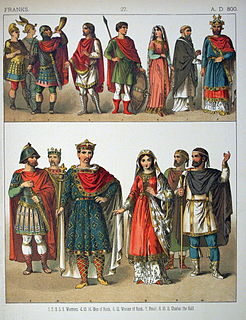
Costume is the distinctive style of dress of an individual or group that reflects class, gender, profession, ethnicity, nationality, activity or epoch.
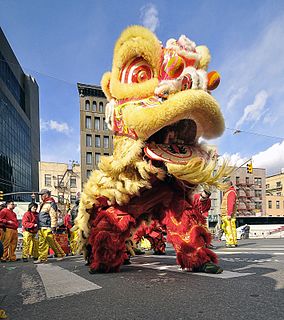
Lion dance is a form of traditional dance in Chinese culture and other Asian countries in which performers mimic a lion's movements in a lion costume to bring good luck and fortune. The lion dance is usually performed during the Chinese New Year and other Chinese traditional, cultural and religious festivals. It may also be performed at important occasions such as business opening events, special celebrations or wedding ceremonies, or may be used to honour special guests by the Chinese communities.

Northeast India is the easternmost region of India representing both a geographic and political administrative division of the country. It comprises eight states – Arunachal Pradesh, Assam, Manipur, Meghalaya, Mizoram, Nagaland, Sikkim and Tripura. The region shares an international border of 5,182 kilometres (3,220 mi) with several neighbouring countries – 1,395 kilometres (867 mi) with Tibet Autonomous Region, China in the north, 1,640 kilometres (1,020 mi) with Myanmar in the east, 1,596 kilometres (992 mi) with Bangladesh in the south-west, 97 kilometres (60 mi) with Nepal in the west, and 455 kilometres (283 mi) with Bhutan in the north-west. It comprises an area of 262,230 square kilometres (101,250 sq mi), almost 8 percent of that of India
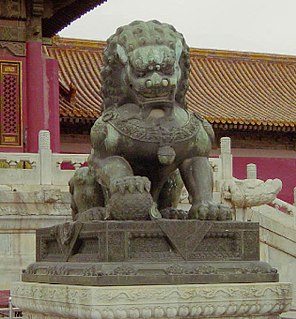
Chinese or Imperial guardian lions are a traditional Chinese architectural ornament. Typically made of stone, they are also known as stone lions or shishi (石獅、shíshī). They are known in colloquial English as lion dogs or foo dogs. The concept, which originated and became popular in Chinese Buddhism, features a pair of highly stylized lions—often one male with a ball and one female with a cub—which were thought to protect the building from harmful spiritual influences and harmful people that might be a threat. Used in imperial Chinese palaces and tombs, the lions subsequently spread to other parts of Asia including Japan, Korea, Tibet, Thailand, Burma, Vietnam, Sri Lanka, Nepal, Cambodia, Laos, Taiwan, and Singapore.
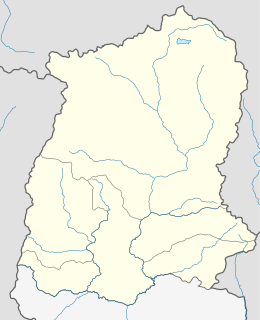
Rumtek Monastery, also called the Dharma Chakra Centre, is a gompa located in the Indian state of Sikkim near the capital Gangtok. It is the seat-in-exile of the Gyalwang Karmapa, inaugurated in 1966 by the 16th Karmapa. It is also a focal point for the sectarian tensions within the Karma Kagyu school of Tibetan Buddhism that characterize the 17th Karmapa controversy.

The Limbu (ᤕᤠᤰᤌᤢᤱ) (exonym) or Yakthung (endonym) are indigenous and native to the Himalayan Limbuwan region of the Indian subcontinent, what is now Eastern Nepal, Northern Sikkim, Kalimpong India and Western Bhutan.

The Lepcha are also called the Rongkup meaning the children of God and the Rong, Mútuncí Róngkup Rumkup, and Rongpa, are among the indigenous peoples of Sikkim, India and Nepal, and number around 80,000. Many Lepcha are also found in western and southwestern Bhutan, Tibet, Darjeeling, the Mechi Zone of eastern Nepal, and in the hills of West Bengal. The Lepcha people are composed of four main distinct communities: the Renjóngmú of Sikkim; the Dámsángmú of Kalimpong, Kurseong, and Mirik; the ʔilámmú of Ilam District, Nepal; and the Promú of Samtse and Chukha in southwestern Bhutan.

Music of Jammu and Kashmir and Ladakh reflects the rich musical heritage and cultural legacy of the union territories of Jammu and Kashmir and Ladakh. Two different regions of Jammu and Kashmir, consists upper Jammu Division and Kashmir Valley's music is closer to Central Asian music while music from Jammu region is similar to that of North India and Ladakhi music is similar to the music of Tibet.

Gangtok is a city, municipality, the capital and the largest town of the Indian state of Sikkim. It is also the headquarters of the East Sikkim district. Gangtok is in the eastern Himalayan range, at an elevation of 1,650 m (5,410 ft). The town's population of 100,000 are from different ethnicities such as Bhutia, Lepchas and Indian Gorkhas. Within the higher peaks of the Himalaya and with a year-round mild temperate climate, Gangtok is at the centre of Sikkim's tourism industry.

The Bhutia are a community of Sikkimese people of Tibetan ancestry, who speak Lhopo or Sikkimese, a Tibetan dialect fairly mutually intelligible with standard Tibetan. In 2001, the Bhutia numbered around 60,300. Bhutia here refers to Chinese of Tibetan ancestry;

The Chogyal were the monarchs of the former kingdoms of Sikkim and Ladakh in present-day India, which were ruled by separate branches of the Namgyal dynasty. The Chogyal was the absolute monarch of Sikkim from 1642 to 1975, when the monarchy was abolished and its people voted in a referendum to make Sikkim the 22nd state of India.
In Indian cinema, an item number or item song is a musical number inserted into a film that may or may not have any relevance to the plot. The term is commonly used within Indian films to describe a catchy, upbeat, often sexually provocative dance sequence for a song in a movie. The main aim of an item number is to entertain movie-goers and to lend support to the marketability of the film by being featured in trailers. They are favoured by filmmakers as they afford the opportunity pick potential hit songs from the stocks, since they do not add to the continuity of the plot. It is thus a vehicle for commercial success that ensures repeat viewing.
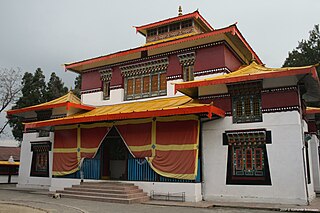
The Enchey Monastery was established in 1909 above Gangtok, the capital city of Sikkim in the Northeastern Indian state. It belongs to the Nyingma order of Vajrayana Buddhism. The monastery built around the then small hamlet of Gangtok became a religious centre. The location was blessed by Lama Drupthob Karpo, a renowned exponent of tantric (adept) art in Buddhism with flying powers; initially a small Gompa was established by him after he flew from Maenam Hill in South Sikkim to this site. The literal meaning of Enchey Monastery is the "Solitary Monastery". Its sacredness is attributed to the belief that Khangchendzonga and Yabdean – the protecting deities – reside in this monastery. As, according to a legend, Guru Padmasambhava had subdued the spirits of the Khangchendzonga, Yabdean and Mahākāla here. In view of this legend, the religious significance of Enchey Monastery is deeply ingrained in every household in Gangtok. It is also believed that these powerful deities always fulfil the wishes of the devotees.

The Snow Lion, sometimes also Snowlion, is a celestial animal of Tibet. It is the emblem of Tibet, representing the snowy mountain ranges and glaciers of Tibet, and may also symbolize power and strength, and fearlessness and joy, east and the earth element. It is one of the Four Dignities. It ranges over the mountains, and is commonly pictured as being white with a turquoise mane. In Journey to the West published in 1592, Snow Lion is depicted as one of Yōkais .

The British expedition to Tibet, also known as the British invasion of Tibet or the Younghusband expedition to Tibet began in December 1903 and lasted until September 1904. The expedition was effectively a temporary invasion by British Indian forces under the auspices of the Tibet Frontier Commission, whose purported mission was to establish diplomatic relations and resolve the dispute over the border between Tibet and Sikkim. In the nineteenth century, the British had conquered Burma and Sikkim, with the whole southern flank of Tibet coming under the control of the British Raj. Tibet, ruled by the Dalai Lama under the Ganden Phodrang government, was the only Himalayan state under Chinese instead of British influence.
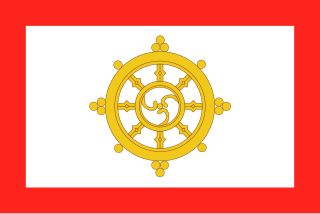
The Kingdom of Sikkim, earlier known as Dremoshong, was a hereditary monarchy from 1642 to 16 May 1975 in the Eastern Himalayas. It was ruled by Chogyals of the Namgyal dynasty.

The Pemayangtse Monastery is a Buddhist monastery in Pemayangtse, near Pelling in the northeastern Indian state of Sikkim, located 110 km west of Gangtok. Planned, designed and founded by Lama Lhatsun Chempo in 1647, it is one of the oldest and premier monasteries of Sikkim, also the most famous in Sikkim. Originally started as a small Lhakhang, it was subsequently enlarged during the reign of the third Chogyal Chakdor Namgyal and Khenchen Rolpai Dorjee in the year 1705 and consecrated by the third Lhatsun Chenpo Dzogchen Jigme Pawo in the year 1710 C.E. The monastery follows the Nyingma Order of Tibetan Buddhism and controls all other monasteries of that Order in Sikkim. The monks of this monastery are normally chosen from the Bhutias of Sikkim.

Kachchhi Ghodi dance, also spelled Kachhi Ghodi and Kachhi Gori, is an Indian folk dance that originated in the Shekhawati region of Rajasthan. It has since been adopted and performed throughout the rest of the country. Dancers wear novelty horse costumes, and participate in mock fights, while a singer narrates folk tales about local bandits. It is commonly performed during wedding ceremonies to welcome and entertain the bridegroom’s party, and during other social settings. Performing the dance is also a profession for some individuals.

Singo Ulung is one of the original traditional dances from Bondowoso regency. The dance is played by two people in a lion-like costume and accompanied by music. This traditional dance originally came from Blimbing village, Klabang district, Bondowoso Regency, East Java, Indonesia
References
- ↑ "Singhi Chham Dance". India9. 29 January 2019. Retrieved 17 September 2020.
- ↑ Shobhna Gupta (2007). Dances of India. Har-Anand. p. 76. ISBN 978-8124108666.
| This article about Indian dance is a stub. You can help Wikipedia by expanding it. |